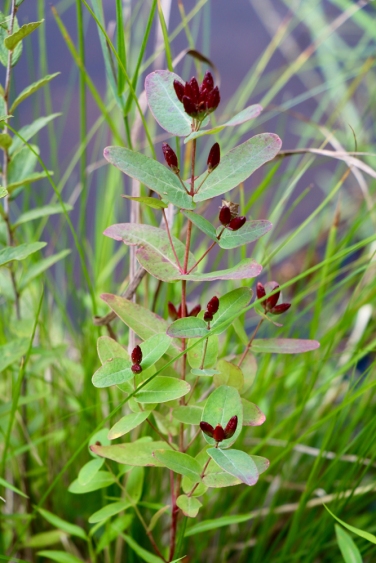Triadenum virginicum
September arrived in Blacksburg this week on the heels of cold front. Suddenly the evening temperatures dropped into the 50’s and the breezy, pleasant afternoons called for long sleeves. Roll that weather forecast into a long, Labor Day weekend, and needless to say, we had to get out for a few hikes in the mountains!
The roadside ditches heading into the Jefferson National Forest were packed with tall wildflowers like Joe Pye Weed, Ironweed, Wingstem, Crownbeard, and Queen Anne’s Lace. The wet areas were still hosting orange Jewelweed, white Boneset, bright red Cardinal Flower and Great Blue Lobelia. Once we got into the National Forest, we stopped at Cherokee Flats and wandered along the banks of Big Stony Creek, where we found Beechdrops coming up everywhere, Grass of Parnassis in bloom along the water, and an abundance of very cool mushrooms popping up here and there.
Eventually we made our way to the beaver pond at Glen Alton, where I found this new plant growing on the banks of the wetland, near where I photographed Steeplebush a few years ago. The “new” plant was not in bloom, although I definitely thought it was at first glance. On closer inspection, I discovered that what first looked like red flower buds were actually an abundance of dark red, conical seed capsules. Hmmm…what IS this plant? I have no idea, but I do have my camera…

Check out the photos and let’s go through the all the details we can, since we don’t have a flower to inspect: The leaves are simple, opposite, entire, ovate, and heart-shaped at the base where they “clasp” the red stem (there are no petioles). The leaves and stems are smooth, not hairy. The plants are growing on the banks of a pond/swamp, and it isn’t growing in the dry areas at all. In terms of color, the leaves are varying shades of blue-green, pink and purple, and the stems are dark red. The seedpods are at the top of the plant, but also in the leaf axils, which means that is where the flowers would have been too, if only we had been there to see them.
This species was a challenge for me to identify, but I think I have it now. This is Virginia Marsh St. Johnswort, a perennial wetland species. If we were lucky enough to see it in bloom, it would have pink, 5-petalled flowers. The showy little flowers have an abundance of yellow-tipped stamens (like other St. Johnsworts). From what I’ve read, it is rare to see this plant in flower in the daylight hours. The flowers open late in the day and close in the morning. It is pollinated at dusk and dawn by crepuscular insects.
Marsh St. Johnswort grows 12 to 24 inches tall and blooms in mid-to-late summer. The blue-green leaves eventually turn reddish purple toward autumn. It was previously named Hypericum virginicum.
In the gallery below, I have borrowed, with permission, two photos of the plant in bloom. The photos are provided by Allen Norcross of New Hampshire Garden Solutions. Thanks, Allen!
Also in the gallery are several photos of another St. Johnswort species that was growing nearby. This yellow-flowering plant is Bushy St. Johnswort, Hypericum densiflorum. It is taller, woody, and more shrub-like than the Marsh St. Johnswort.
RELATED: Spotted St. Johnswort












I can verify that this is a hard flower to get a photo of. There are plants that grow right across the road from where I work and I checked them every day for at least two weeks before I saw a blossom. That just happened to be on the day of the recent total eclipse! I found it blooming at around noon time.
If it’s a cloudy day they never open, no matter what time it is.